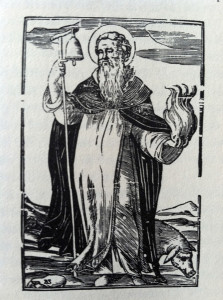We celebrate three notable saints’ days in mid-January, beginning today with the feast of St. Anthony the Abbot, Sant’Antonio Abate in Italy, where this day is a very big deal… mainly for the food. It is the traditional day for dispatching the family pig, which is not a very good day for the pig, of course, but which brings on a feast of epic proportions revolving around dishes whose main ingredient is pork. It is a day of salting, curing, and smoking, to make sausages and salame and prosciutto and pan con i ciccioli––bread baked with pork cracklings––which I loved as a kid but which we rarely eat nowadays in our more health conscious world.
On the eve of Sant’Antonio, which was last night, there are many great bonfires throughout Italy, especially at crossroads and in church piazze, to warm the cold winter’s night. And while St. Anthony’s Day may not be a very good day to be a pig in Italy, still, St. Anthony the Abbot is a patron saint of domestic animals, and as their protector, he is always depicted with a pig at his side. He also happens to be a patron saint of bakers (perhaps the bakers who came up with pan con i ciccioli).
Three days following, on January 20, brings the feast of St. Sebastian, and while there are no particular traditions that I know of associated with St. Sebastian, it is worth noting that he is one of the saints most often depicted in art, usually as a very handsome youth, practically naked and bound to a tree, shot through with arrows. He was a favorite subject of Renaissance painters, and artists have been fascinated with St. Sebastian ever since.
The following evening, January 21, is the Eve of St. Agnes. There is an old tradition related to St. Agnes Eve in which young girls go to bed without supper, not as a punishment but rather so as to dream of their future husbands. The poet John Keats wrote about this legend in his poem, “The Eve of St. Agnes”:
. . . how, upon St. Agnes’ Eve,
Young virgins might have visions of delight,
And soft adorings from their loves receive
Upon the honey’d middle of the night.
I love that last line. Helen Barolini, in her book Festa, which I was lucky enough to stumble upon at a library book sale and which has become one of my favorite books, also writes about the Eve of St. Agnes. Helen’s husband was the writer Antonio Barolini, and for her, the night and its customs are more personal. What she wrote in her book about this night always moves me, and I hope she wouldn’t mind my closing today with her words, describing her fascination with St. Agnes Eve when she was a young girl:
And though I fasted and hoped to see my intended as I slept on that eve, I never did picture Antonio Barolini in my imagination or in my dreams. But now I think how strange it is that his death came on January 21, Saint Agnes Eve.
Image: Sant’Antonio Abate with his pig.
